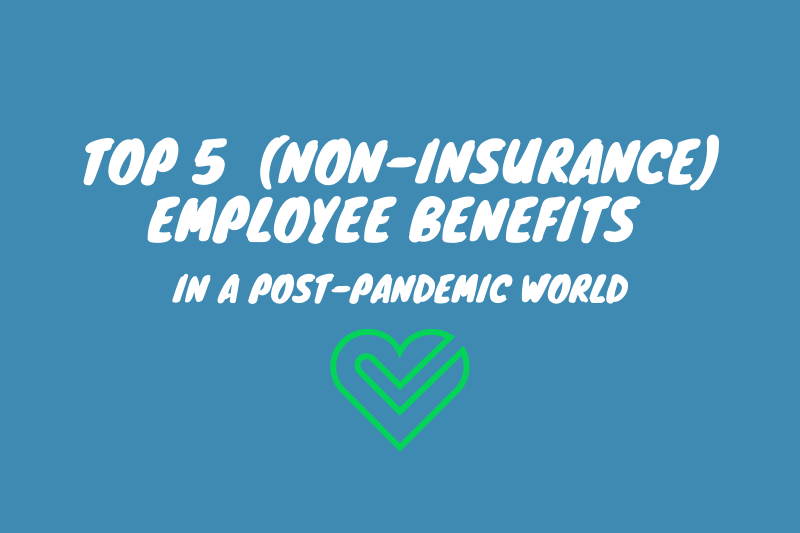In a post-pandemic world, the most popular non-insurance employee perks still revolve around time away from work.
As we hopefully start to see the COVID-19 pandemic in the rearview mirror and more people flock to their offices again, employers are facing an unprecedented challenge. In 2021, company policies that promote a healthier work-life balance will be critical to keeping staff and increasing productivity once office workers return to their workplace.
Although fewer Americans traveled over the last year, and a considerable amount of people were working from home, you may be surprised to know that workers didn’t take as much time off in 2020. This has made it difficult for employers to recognize poor work-life balance among their employees, but that is bound to change. So how can you prepare for this?
What are the telltale signs of poor work-life balance?
- A dip in productivity.
- A sudden spike in overtime.
- A slew of requests to take time off to deal with ’emergencies.’
- An increased rate of absenteeism.
- A high rate of staff turnover.
If you foresee that any of these symptoms could affect your company, you might need an updated benefits package that eases your personnel’s transition as they come back to your offices. These kinds of benefits, often intangible, help create a more balanced work-life ratio that should improve life quality and satisfaction.
The good news is that you don’t need to break the bank to achieve this. Sure, when you think about ‘perks,’ maybe the first thing that comes to mind is health insurance and stock options. Besides the two major types of employee benefits (medical and retirement plans), several alternatives have gained popularity over the years that are relatively low-cost to employers.
Emerging employee benefits for a healthy work-life balance
1) More vacation time
Time remains the most valuable commodity for employees. Whenever specialized organizations conduct surveys, paid time off is always one of the most appealing perks for the majority of respondents. People value PTO, sick days, and vacation days more than ever because they have become aware that perhaps you could make more money, but you can never make more time.
It seems that after the COVID-19 pandemic, lifestyle benefits like more vacation days or paid time off have become more valuable than a salary raise. Many companies have instituted unlimited vacation policies.
2) Flex-time schedules
When it comes to a healthy work-life balance, there are no hard-and-fast rules. Flexible hours and remote working options have become among the most popular employee perks in 2021. Not all organizations can offer open-ended flex-time, but if you can offer it, give your staff some authority about their working hours or whether they would like to work from home or somewhere else entirely, can increase their work satisfaction and productivity. This option is often a cost-effective benefit most employers can offer due to its low overhead cost.
3) Wellness programs
Besides medical plans, many other benefits can promote a healthy work-life balance. Paying for physiotherapy, yoga classes, meditation offerings, coaching, and even psychological support have become popular options. In fact, wellness programs designed to help employees improve their mental health have jumped in importance over the last year.
Potentially faced with long work hours on top of the return of long commutes, prioritizing your employee’s health is paramount. Anything from simpler (and cost-efficient) activities such as company-wide steps-based contests, or more robust wellness programs that include a wide array of paid activities, is something employees will surely appreciate.
4) Gym memberships
We have already established that exercising helps people get through the workday. But if in-office wellness programs are not your thing, you could always offer other fitness-related perks such as gym memberships and yoga classes. Making easy, affordable access to exercise prevents your employees from falling into the sedentary lifestyle that is pervasive in today’s modern office environment.
5) Family-focused workplace policies
Companies should consider introducing initiatives to offer staff support on a personal level. For example, something as simple as covering childcare or paying for grocery delivery can significantly affect your employees’ work-life balance. These kinds of policies reduce stress and financial pressures for your employees.
It’s a two-way street
Work-life balance is beneficial for both employers and employees. These types of perks have been known to increase productivity, reduce absenteeism, and lead to an overall happier working environment because your staff feels more valued. When you promote a positive balance between work and home, you help everyone involved with your company thrive in all aspects of their lives.
Can’t miss reading (for employers and employees):
- Principles: Life and Work by Ray Dalio
- It Doesn’t Have to Be Crazy at Work by Jason Fried & David Heinmemeier Hanson
- Work-Life Brilliance by Denise R. Green
- Work-Passion-Life Balance by Dr. Matthew Kolinski
- Lead With Balance: How To Master Work-Life Balance in an Imbalanced Culture by Donnie Hutchinson

